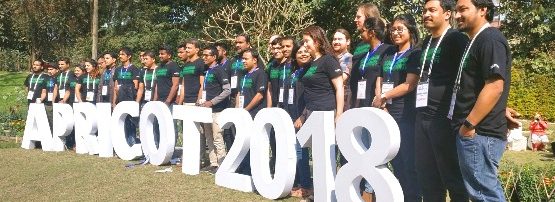
Here at APRICOT 2018/APNIC 45, we’re almost at the end of APNIC’s first two-day Hackathon. The theme is IPv6 and five teams comprising participants from eight economies have been exploring the space with a range of novel, entertaining and informative ideas.
One group has decided to look at how Content Distribution Networks (CDNs) look from an IPv6 perspective and have set out to map CDN IP spaces visible from the conference. In the process they uncovered an awkward truth about movable meeting networks: they don’t always geo-locate well — the last conference was in a different economy, and the CDN’s decision-logic misattributed the network and pointed to the wrong location. That problem resolved, the group has a firm grasp on building out some knowledge of the IP spaces presented by CDNs to a range of hosts, and how they can compare their performance on IPv4 and IPv6.
Another team has decided to ‘gamify’ the process of collecting end-user visible IPv6. It’s a “gotta catch ’em all” pokemon model of ranking and badging new IPv6 prefixes and new IPv6-announcing ASNs, which encourages participation for the minor ‘win’ of table rank and naming rights. Overall, an interesting and quirky approach to motivating people to collect data.
The third team has taken on the ‘tunnels are bad’ meme and are thinking hard about how to quantify and qualify the tunnel problem on the path, and near to the user. Can they build a system to display and inform about tunnel status on top of what we know about the global routing system? How will they validate what is, or is not tunnelled IPv6?
The fourth team is taking a ‘web 2.0’ approach to integrating data from multiple sources into one cohesive page to provide country and region-specific summaries of IPv6 usage. They have to deal with the IPR issues in sourcing other people’s web data, but there is a useful tool being built here to provide a view to anyone interested in a specific economy’s IPv6 status with data from disparate sources with attribution – a one-stop shop for IPv6 data.
Finally, the fifth team is documenting the security issues for newly turned-up IPv6 end-user networks. Current security guides make some assumptions about what people know and are familiar to them, and this group is focusing on how to tell the security story well for new entrants, and provide some improvements in IPv6 secure configuration.
What’s become clear is that no single skill (coding, web design, project management, or domain-specific knowledge) rules overall in this activity. You need a mix of approaches, skills, competencies, and inputs to make this kind of project work.
The jury, composed of representatives from APRICOT’s program committee, APNIC, the RIPE NCC, and local experts, will have to select the best group outcome on a range of measures.
Stay tuned for our post about the results of this amazing experience we are having with the first APNIC Hackathon.
The views expressed by the authors of this blog are their own and do not necessarily reflect the views of APNIC. Please note a Code of Conduct applies to this blog.

It’s a great opportunity to participate 1st APNIC IPv6 Heckathon. I have a great experience regarding IPv6. The heckathon was not only a contest but also a plaform where different diversity of people could met, share their ideas regarding IPv6. Thanks APNIC, Sunny, Silvia and all.